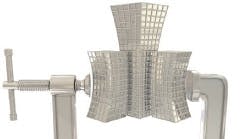The green movement has gained considerable traction in the design of new buildings, from office properties and residential construction to warehouses and tension fabric storage facilities.
The hallmark of green building comes in the form of LEED (Leadership in Energy and Environmental Design) certification through the U.S. Green Building Council, which is achieved by meeting various design and operating criteria. But even for those building owners who choose not to go through the LEED process, greater energy efficiency and the subsequent reduction in operating expenses have become their highest priorities when erecting a new building.
Naturally Green Fabric
For storage structures, warehouses and other locations where goods are handled, a certain level of energy efficiency is achieved simply by installing a building with a tension fabric roof. Both polyvinyl chloride (PVC) and polyethylene (PE) fabrics continue to improve in quality, and their natural properties make fabric roofs suitable for green-conscious building users.
The primary advantage of these structures from a sustainability standpoint is that fabric offers a high solar reflectance, keeping the roof cooler and reducing the heat island effect in the area by reflecting sunlight’s heat away from the building. Along with reflectance, tension fabric’s high thermal emittance also contributes to the roof absorbing less heat. During peak summer weather, these properties can combine to keep fabric roofs about 50 to 60 degrees cooler than roofs built with conventional materials, thereby reducing the need for temperature control measures inside the building.
Although fabric roofs are reflective, they also offer up to 12-percent translucency to allow natural light to permeate the structure. Direct sunlight offers about 10,000 footcandles of illumination, so even at 5-percent translucency, a fabric roof will let approximately 500 footcandles into a building on a sunny day — well above the minimum 20-footcandle guideline for lighting inside a warehouse.
Most structures will still need artificial lights for nighttime work and to provide adequate illumination on stormy, overcast days, but during normal daylight hours, fabric roofs effectively eliminate the need for artificial lighting. By taking advantage of natural sunlight, tension fabric contributes to reducing the electricity bill and making a building more energy efficient.
These benefits also help to rapidly accumulate points on the path to LEED certification.
Sustainable Engineering
Another aspect of sustainability in tension fabric facilities includes the use of structural steel beams rather than hollow-tube, open web-truss framing. This rigid-frame engineering concept allows design flexibility in customizing the size and alignment of a fabric building, while also allowing builders to incorporate additional features to make the structure more operationally and energy efficient.
Because the rigid frame is a more traditional architectural design that gives a fabric building more strength, it’s become easier to add items like interior fabric liners and insulation to a structure’s roof and sidewalls. A certain temperature control barrier can be achieved simply by adding a liner to the main fabric skin. The liner can also be combined with insulation material to create a system with an insulation value of up to R-40. This level is capable of meeting most energy codes in the country, providing significant heating and cooling cost savings.
Another feature affecting a fabric building’s interior environment is ventilation, which can be accomplished through passive or mechanical means. Fans or heavy-duty systems can be mounted on a rigid frame structure if necessary, but users can also choose a natural gravity ventilation system that relies simply on the movement of hot air.
As hot air rises, it works with pressure intakes around the perimeter of the building at the base and a gravity ventilator at the ridge to create circulation inside the building. By providing a natural intake for fresh air and an evacuation point for fumes without the need for powered equipment, users can save on energy consumption and operating costs.
In addition to taking advantage of potential energy savings, some building owners will opt to create their own power using solar panels. This makes them even less dependent on outside power and, in some cases, allows them to become self-sufficient in terms of energy usage.
An emerging trend still being tested by some industry manufacturers involves the use of a thin-filmed photovoltaic that can be adhered directly to the building’s fabric panels. A less sophisticated system for buildings looking for solar heating in the winter uses perforated metal to capture hot air in a cavity and bring it into the structure. Traditional crystalline or silicon panels can be incorporated within a building design as well.
In addition to being inherently energy-efficient, rigid-frame style tension fabric warehouses also use existing resources efficiently. The structural steel I-beams in a typical rigid frame fabric building contain almost 90% recycled steel. Buildings can also be fitted with basic gutters and downspouts to collect rain runoff into cisterns for later use around the facility when water is needed.
Getting Started
Although LEED has been around in one form or another since 1998 and there’s certainly a keen awareness of green building among the general public, most industries still find themselves abiding by the 80/20 rule — where the 20-percent of building users and manufacturers who recognize the importance of energy and resource management are trying to drag the other 80-percent along for the ride.
It’s a given that many will never see the value in going through LEED certification and putting a plaque on the wall to promote their commitment to sustainability. But another virtual certainty is that as more and more material handling facility owners experience long-term energy savings, the adoption of sustainable structure design will be easier to justify.
Tom Ruprecht is director of Legacy Building Solutions (www.legacybuildingsolutions.com).





